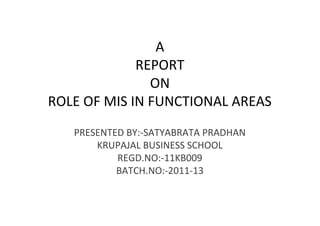
Role of mis in functional areas
- 1. A REPORT ON ROLE OF MIS IN FUNCTIONAL AREAS PRESENTED BY:-SATYABRATA PRADHAN KRUPAJAL BUSINESS SCHOOL REGD.NO:-11KB009 BATCH.NO:-2011-13
- 2. Management Information Systems (MIS) • Management information system (MIS) • An MIS provides managers with information and support for effective decision making, and provides feedback on daily operations • Output, or reports, are usually generated through accumulation of transaction processing data • Each MIS is an integrated collection of subsystems, which are typically organized along functional lines within an organization
- 3. Employees Corporate Databases Corporate databases of intranet of external internal data data Decision support systems Transaction Databases Management Executive Business processing of information Application support transactions systems valid systems databases systems transactions Drill-down reports Expert Exception reports systems Demand reports Operational Key-indicator reports databases Input and Scheduled error list reports
- 4. Outputs of a Management Information System • Scheduled reports • Produced periodically, or on a schedule (daily, weekly, monthly) • Key-indicator report • Summarizes the previous day’s critical activities • Typically available at the beginning of each day • Demand report • Gives certain information at a manager’s request • Exception report • Automatically produced when a situation is unusual or requires management action
- 5. Functional Aspects • MIS is an integrated collection of functional information systems, each supporting particular functional areas.
- 6. Internet An Organization’s MIS Financial Business MIS transactions Drill down reports Accounting Transaction Databases MIS Exception reports processing of Demand reports systems valid transactions Key-indicator reports Marketing MIS Scheduled reports Business transactions Databases Human of Resources Etc. external data MIS Extranet Etc.
- 7. Financial MIS • Provides financial information to all financial managers within an organization.
- 8. Databases of Financial Databases of internal data external data DSS Business transactions Transaction Databases processing of valid Financial systems transactions MIS Financial for each applications TPS databases Business transactions Financial statements Financial Operational Uses and management ES Internet or databases of funds Extranet Financial statistics for control Business Customers, transactions Suppliers
- 9. Inputs to the Financial Information System • Strategic plan or corporate policies – Contains major financial objectives and often projects financial needs. • Transaction processing system (TPS) – Important financial information collected from almost every TPS - payroll, inventory control, order processing, accounts payable, accounts receivable, general ledger. – External sources – Annual reports and financial statements of competitors and general news items.
- 10. Financial MIS Subsystems and Outputs • Financial subsystems – Profit/loss and cost systems – Auditing – Internal auditing – External auditing – Uses and management of funds
- 12. Databases of Manufacturing Databases of internal data external data DSS Business transactions Transaction Databases processing of valid Manufacturing systems transactions MIS Manufacturing for each applications TPS databases Business Quality control reports transactions Process control reports Manufacturing Operational ES Internet or JIT reports databases Extranet MRP reports Production schedule CAD output Business Customers, transactions Suppliers
- 13. Inputs to the Manufacturing MIS • Strategic plan or corporate policies. • The TPS: – Order processing – Inventory data – Receiving and inspecting data – Personnel data – Production process • External sources
- 14. Manufacturing MIS Subsystems and Outputs • Design and engineering • Master production scheduling • Inventory control • Manufacturing resource planning • Just-in-time inventory and manufacturing • Process control • Computer-integrated manufacturing (CIM) • Quality control and testing
- 15. Marketing MIS • Supports managerial activities in product development, distribution, pricing decisions, and promotional effectiveness
- 16. Databases of Manufacturing Databases of internal data external data DSS Transaction Databases Business processing of valid Marketing transactions systems transactions MIS Marketing for each applications TPS databases Sales by customer Sales by salesperson Manufacturing Operational Sales by product ES databases Pricing report Total service calls Customer satisfaction
- 17. Inputs to Marketing MIS • Strategic plan and corporate policies • The TPS • External sources: – The competition – The market
- 18. Marketing MIS Subsystems and Outputs • Marketing research • Product development • Promotion and advertising • Product pricing
- 19. Human Resource MIS • Concerned with all of the activities related to employees and potential employees of the organization
- 20. Databases of Manufacturing Databases of internal data external data DSS Transaction Databases Human Business processing of valid Resource Human transactions systems transactions resource MIS for each applications TPS databases Benefit reports Salary surveys Manufacturing Operational Scheduling reports ES databases Training test scores Job applicant profiles Needs and planning reports
- 21. Inputs to the Human Resource MIS • Strategic plan or corporate policies • The TPS: – Payroll data – Order processing data – Personnel data • External sources
- 22. Human Resource MIS Subsystems and Outputs • Human resource planning • Personnel selection and recruiting • Training and skills inventory • Scheduling and job placement • Wage and salary administration
- 23. Other MISs • Accounting MISs – Provides aggregated information on accounts payable, accounts receivable, payroll, and other applications. • Geographic information systems (GISs) – Enables managers to pair pre-drawn maps or map outlines with tabular data to describe aspects of a particular geographic region.
- 24. THANK YOU
